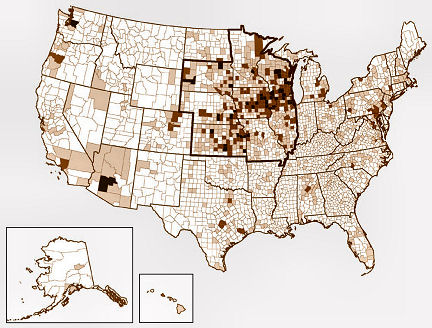Virus Reprise: Mumps outbreak in 2006 was largest in 20 years
Despite the availability of a vaccine to prevent it, mumps has cropped up in the United States, Europe and Canada several times in recent years. U.S. researchers now report that 2006 was the worst year for mumps since the mid-1980s.

The recent outbreak mainly struck college towns in the Midwest, with 85 percent of the infections clustered in eight states. People 18 to 24 years old were nearly four times as likely as people in other age groups to get mumps, an infectious disease marked by swollen salivary glands, headache, fatigue and fever. All told, 6,584 people came down with the illness in 2006, researchers report in the April 10 New England Journal of Medicine.
Most of these people had already been vaccinated against mumps. About 4 percent of all patients under age 30 hadn’t gotten immunized. While the outbreak indicates the protection from the vaccine is incomplete and may have waned, past vaccination probably limited the severity of illness in many cases, says study coauthor Jane Seward, a medical epidemiologist at the Centers for Disease Control and Prevention in Atlanta. There were no fatalities, and the outbreak numbers remained well below levels seen during the pre-vaccine 1950s and 1960s, when mumps infected tens of thousands of people at a time, she says.
Nevertheless, health officials remain concerned.
The vaccine might need to be improved, says study coauthor William Bellini, a molecular biologist at CDC. The mumps vaccine is one-third of a shot called the MMR vaccine, which also prevents measles and rubella. Children typically get an MMR shot as babies and a second dose before attending grade school.
The mumps portion of the vaccine uses a live but weakened strain of mumps that elicits an immune response. But the vaccine dates from the 1960s, Bellini says. While vaccinations undoubtedly prevented thousands of cases in the recent outbreak, he says, bolstering the vaccine with additives that rev up a greater immune reaction might boost coverage. Nearly all people over age 45 have lifelong immunity acquired during childhood exposure to live mumps.
Meanwhile, health officials face a separate problem—fear of vaccination.
“There is a really huge risk to not immunizing,” says William Meller, an internist who teaches at the University of California, Santa Barbara and sees patients in private practice. An anti-vaccine mindset among some parents leaves their children particularly vulnerable when outbreaks strike, he says. Vaccine avoidance “is not based on clearly thought out decision making.”
By some estimates, more than 500 million MMR shots have been given worldwide. Complications are rare, and a hypothetical link between vaccination and autism has never been shown.
On the other hand, contracting the mumps can lead to brain inflammation, swelling of the pancreas and deafness. Men who contract it after puberty can experience swelling of the testicles that on rare occasions results in sterility.
Whether a third dose of the current vaccine would increase immunity remains unknown. In a future outbreak, Bellini says it might be instructive to give young people a third dose to see if it limits disease.
CDC wasn’t able to discern the origin of the 2006 mumps outbreak, though many of the first cases showed up at Iowa State University in Ames. Weeks later, health officials at the University of Kansas in Lawrence suspected mumps immediately when the first three students on their campus with swollen salivary glands also had ties to Iowa. The officials promptly began isolating patients to stem the outbreak.
While mumps has since died down in the United States, outbreaks continue to plague Canada this year. Mumps outbreaks hit Britain in 2004 and Austria in 2006.







